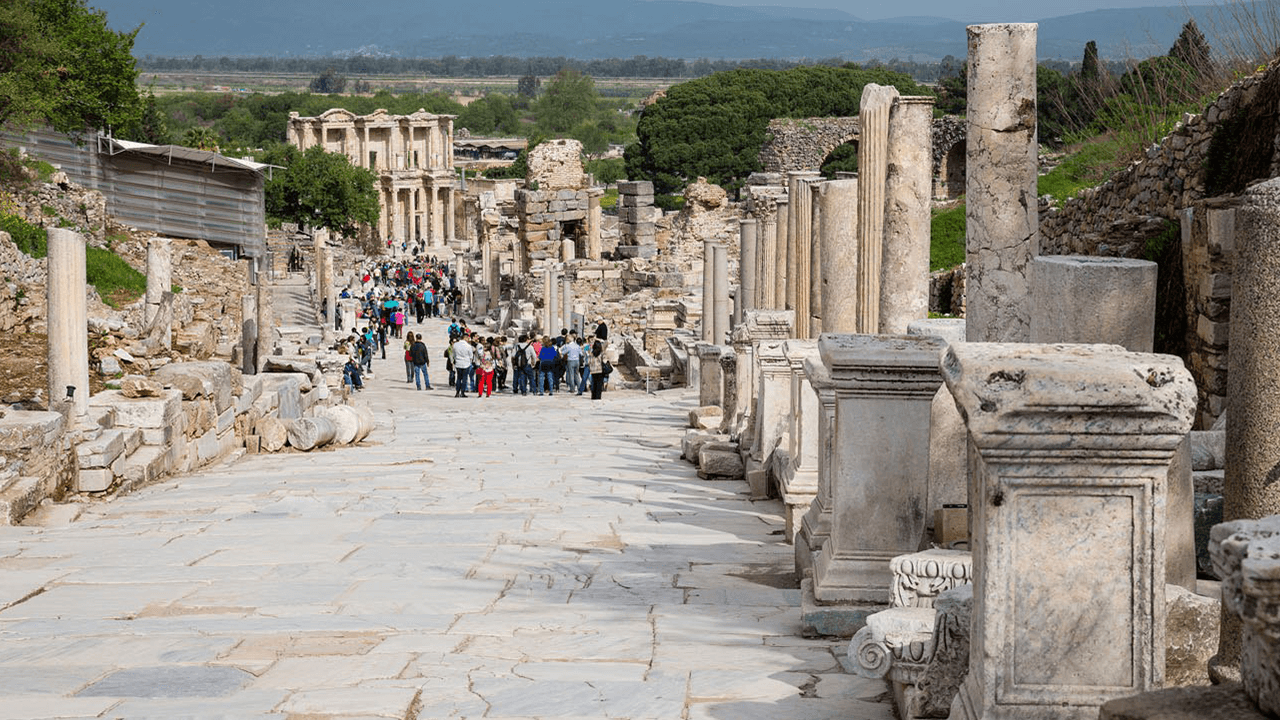The Marble Road in Ephesus: A Monumental Path Between the Great Theater and the Library of Celsus
The Marble Road is one of the most prominent streets of ancient Ephesus. This road connects the Great Theater with the famous Library of Celsus and forms part of the sacred way leading to the Temple of Artemis. Its original construction dates back to the 1st century AD, and it was reconstructed in the 5th century, preserving its historical and cultural significance through the centuries.
History and Construction of the Marble Road
The Marble Road was designed as a monumental path allowing citizens and visitors of Ephesus to access the city’s main points of interest. The road is paved with marble slabs, giving it its name and impressive appearance. This path not only facilitated transit between the Great Theater and the Library of Celsus but also symbolized the wealth and sophistication of Ephesus.
Reconstruction During the Reign of Nero
In the 1st century, during the reign of Nero, significant renovations were made to the Marble Road. One of the key modifications was the construction of an elevated platform on the western side of the road, above the Agora wall, allowing pedestrians to walk safely. This elevated platform highlights the innovative approach of Ephesians to urban organization and architectural design.
A Road with Ancient Advertising
The Marble Road features carvings and drawings that historians believe could be one of the earliest forms of advertising in history. These drawings indicate directions to the city’s brothel, representing an early example of commercial signage. These marble engravings reflect daily life in Ephesus and the creative use of public space.
The First Advertisements in History
These carved advertisements are considered the first in history, showcasing how ancient Ephesus pioneered using public spaces for promoting services. This unique characteristic of the Marble Road adds an intriguing element to the experience of walking this historic path.
Busts, Statues, and Imperial Letters
Along the Marble Road, busts and statues were erected to honor significant figures of the time. Additionally, marble blocks contained inscriptions of letters and decrees from emperors, which were accessible to all citizens. These inscriptions provided relevant information and reflected Ephesus’s connection to the Roman Empire.
The Role of Statues and Letters in Public Life
The busts and statues not only beautified the road but also served as reminders of illustrious individuals who contributed to the city’s development. The letters of emperors engraved in marble kept citizens informed and strengthened Ephesus’s ties with imperial power.
The Western Side of the Marble Road and the Agora Wall
The western side of the Marble Road is bordered by the Agora wall, an essential market in the city. During Nero’s reign, a platform for pedestrians was constructed above the wall, ensuring the safe movement of residents. This platform demonstrates the ingenuity and urban planning of Ephesus during the Roman era.
A Strategic Connection Between the Agora and the Road
The Agora wall and the elevated platform ensured smooth and efficient transit, preventing pedestrian traffic from mixing with the movement of goods in the market. This facilitated commerce and ensured a pleasant experience for those walking the Marble Road.
Tips for Visiting the Marble Road
- Location: The Marble Road stretches between the Great Theater and the Library of Celsus, at the heart of the Ephesus ruins.
- Recommended time: It is best to visit the road early in the morning or late in the afternoon to avoid intense heat and enjoy optimal lighting.
- Respect the site: As an archaeological site, visitors are advised to respect the designated areas and avoid touching inscriptions and sculptures.
Conclusion
The Marble Road in Ephesus is a historic path that combines architectural beauty with the cultural and social significance of its time. From its carved advertisements, considered the first in history, to the statues and imperial letters, this road is a testament to life in ancient Ephesus. Visiting the Marble Road allows visitors to immerse themselves in the past and experience how the Ephesians designed their public spaces for transit, communication, and commerce, leaving behind a legacy that continues to fascinate those who walk this ancient path.














3 thoughts on “The Marble Road”
★★★★★
Highly recommend visiting ‘The Marble Road’—a site rich with history and unparalleled beauty.
★★★★★
Discovering ‘The Marble Road’ was one of the highlights of my trip. Don’t miss out on this gem!
★★★★★
My journey to ‘The Marble Road’ was nothing short of amazing. A must-see for anyone exploring the area!